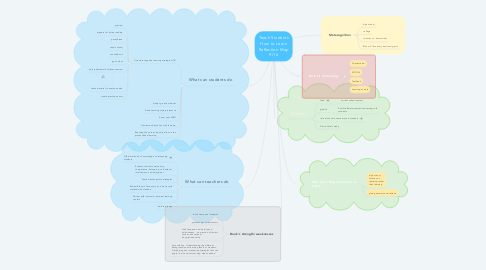Teach Students How to Learn Reflection Map 9/16
by Andrea Cammack


1. What can students do
1.1. Use metacognitive learning strategies (10)
1.1.1. preview
1.1.2. prepare for active reading
1.1.3. paraphrase
1.1.4. read actively
1.1.5. use textbook
1.1.6. go to class
1.1.7. doing homework without answers
1.1.8. teach material to someone else
1.1.9. create practice exams
1.2. Adopt growth mindset
1.3. Know learning style preference
1.4. Know your MBTI
1.5. Get rest and have fun with learning
1.6. Realizing they are an equal partner in the process/their learning
2. What can teachers do
2.1. Other methods of evaluating and assessing students
2.2. Enhance students' autonomy, competence, belonging, self-esteem, involvement, and enjoyment
2.3. Teach metacognitive strategies
2.4. Review Bloom's Taxonomy and study cycle method with students
2.5. Partner with internal or external learning centers
2.6. work in groups
3. Book's strength/weaknesses
3.1. lack of empirical research
3.2. practical tips for educators
3.3. didn't expand on diversity and inclusiveness - no mention of factors such as educational inequity/inequality
3.4. Accessibility - Understanding the different backgrounds and learning levels of students. Developing and presenting strategies that can apply to all, and customizing when needed
4. Metacognition
4.1. high school
4.2. college
4.3. sciences vs. humanitites
4.4. Bloom's Taxonomy and study cycle
5. Mindset
5.1. fixed
5.1.1. current school system
5.2. growth
5.2.1. Positive Reinforcement/connecting with students

